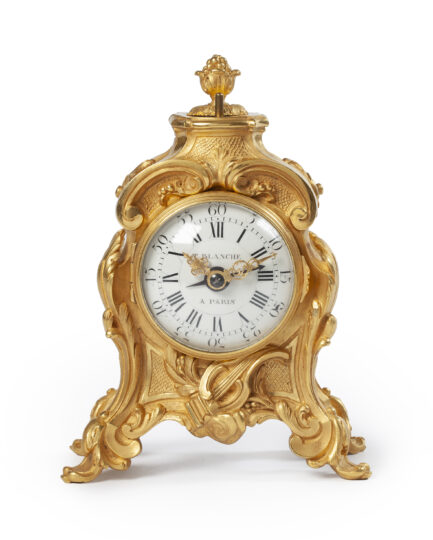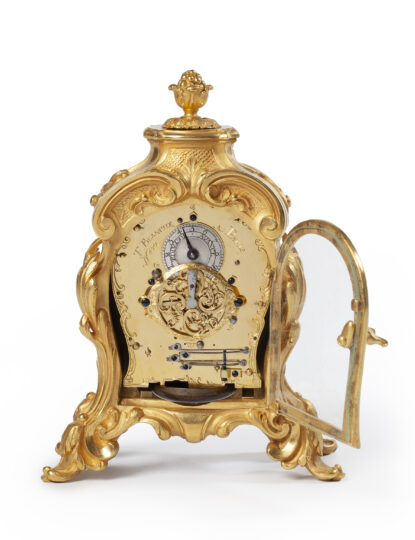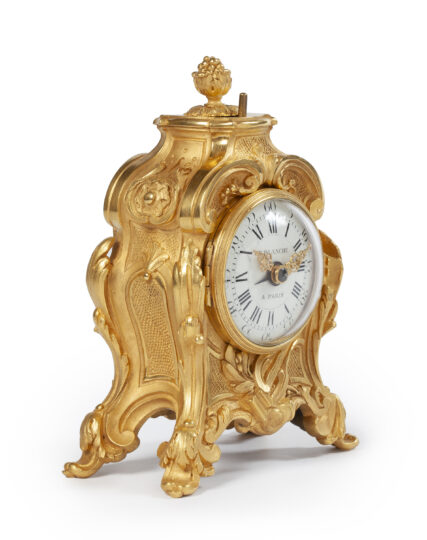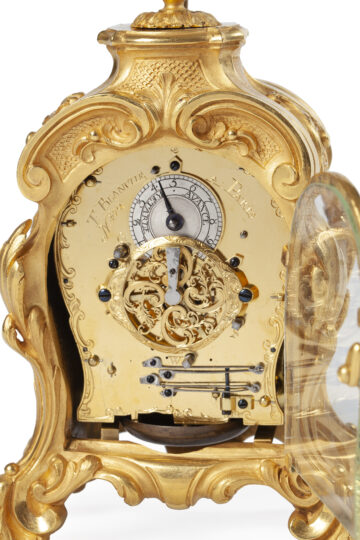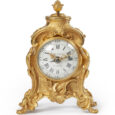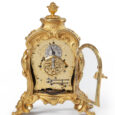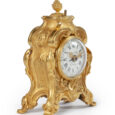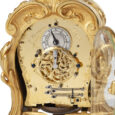FRANCE L. XV PENDULETTE DE VOYAGE, T. Blanche A Paris Ca. 1755
M&R77
L. XV PENDULETTE DE VOYAGE
Signed and numbered: T. Blanche A Paris No .472
Circa 1755
France
Movement
The spring-driven brass movement consists of going and quarter-striking trains. The going train has a spring barrel, chain fusee and verge escapement with an adjustable hairspring balance under a beautifully pierced and engraved balance cock, with a silvered regulation disc. The quarter-striking train indicates the hours fully on a bell and each quarter the number of quarters with a double stroke on the same bell. In addition, the clock has repetition on demand, sounding the hours followed by the quarters. The clock also has alarm, a blued steel hand indicating the alarm time on the chapter ring. The maker has signed and numbered the movement on the backplate T. Blanche A Paris No. 472.
Dial
The circular white enamel dial has a chapter ring with black Roman hour numerals, Arabic five-minute and minute divisions and is protected by a gilt-brass bezel with a convex glass. The time is indicated by a fine pair of pierced and engraved gilt-brass hands. The straight blued steel alarm hand has an arrow shaped end. The maker has signed the dial T. BLANCHE A PARIS.
Case
The firegilt cast brass case is symmetrical with asymmetrical ornaments in floral and scrolling leaf motifs. A musical string instrument is depicted below the dial. The movement can be accessed through a waisted glazed door. The case is surmounted by a pineapple. The button in front of this pineapple activates the quarter-strike repeat. The case rests on four scroll feet, which form integral parts of the case.
Duration: 1 week
Height: 18 cm.
Width: 13 cm.
Depth: 9 cm.
Note
Têteblanche is not mentioned in any clockmakers books or reference works. The outstanding quality of his work, which consists almost exclusively of travelling clocks, however, suggests that he was active in Germany and stayed in Paris only for a limited period of time. The signature most probably refers to Joseph Weishaupt, a master clockmaker active in Karlsbad in the mid-1750s. “Têteblanche” would be the French version of his name; travelling clockmakers often translated their names into the language of the country where they were working. This clock has the letters G. S. W. engraved in the backplate, the German indications of Geh-, Schlag- en Weckerwerk (‘Going, Striking and Alarm train’).
Literature
Tardy, Dictionnaire des Horlogers Français, Paris, 1971, p. 279.
The photo below shows the backplate of a clock by Weishaupt; there are many similarities with the present clock.

